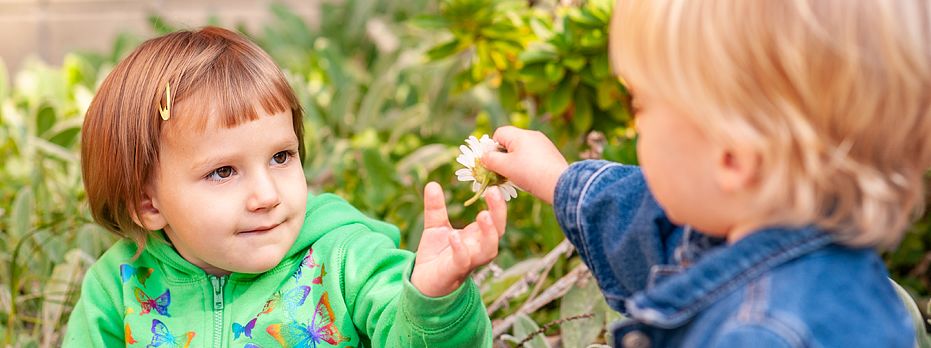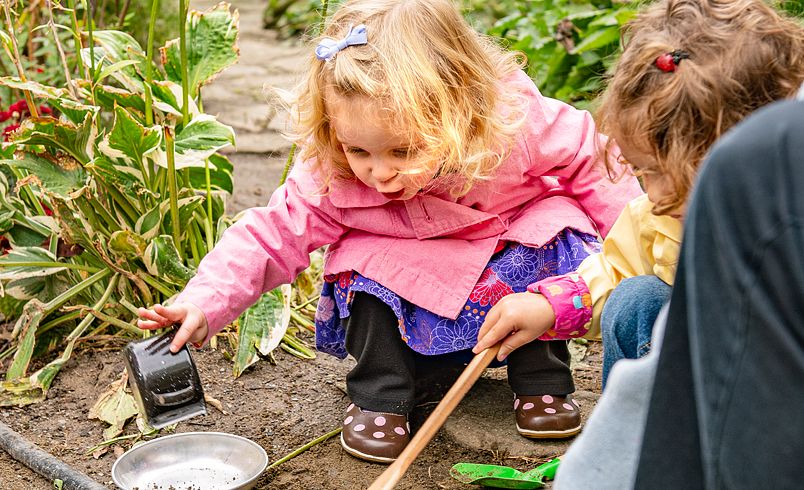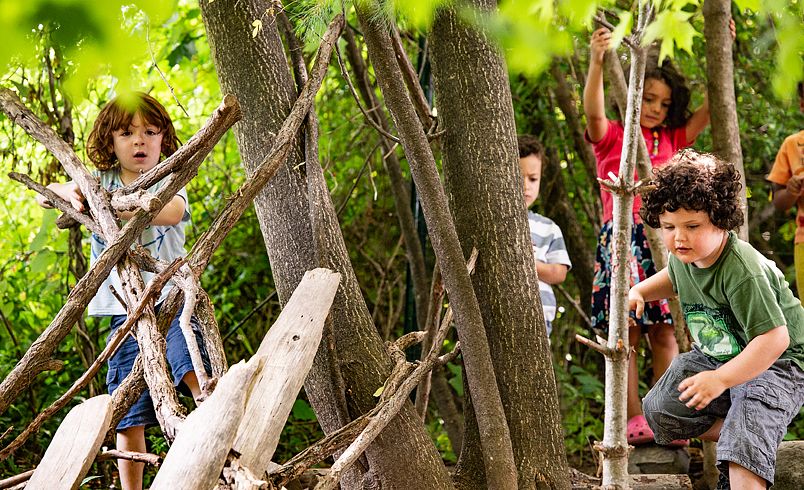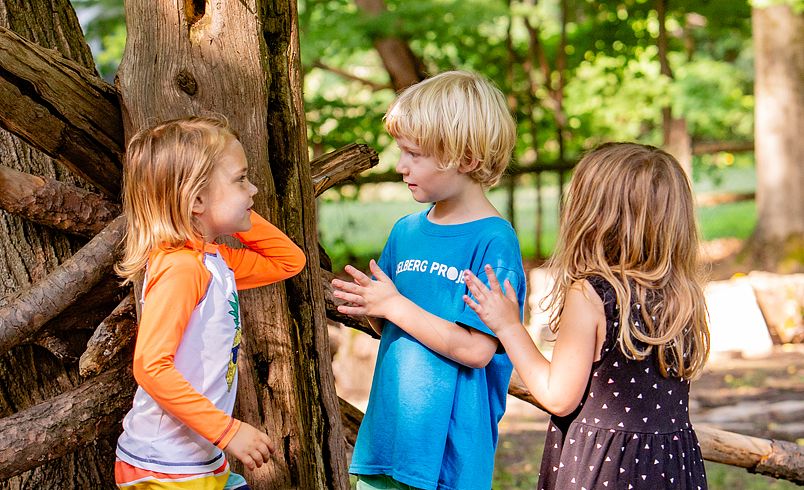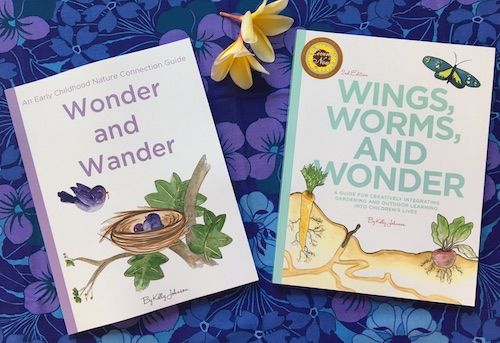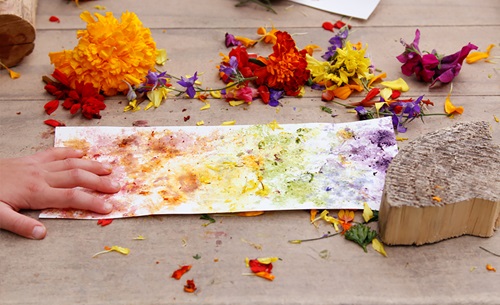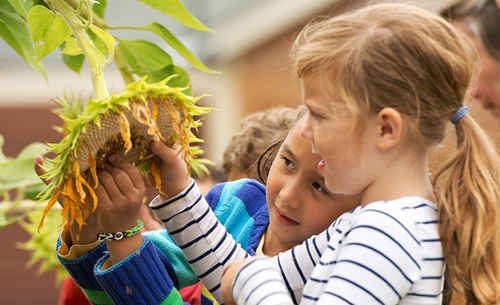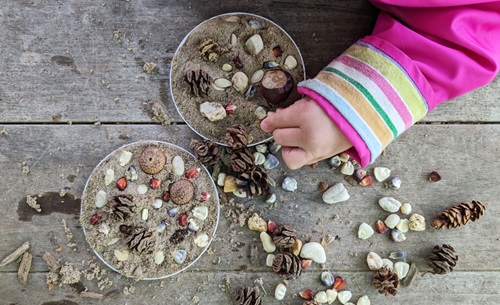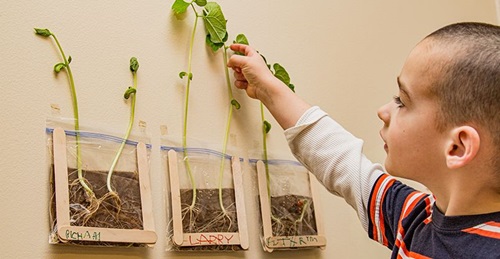Curating Creativity in Outdoor Environments
| March 2020Intentionally curating your outdoor environment with children in mind creates wondrous opportunities for creative outdoor free play. Fortunately, you need neither a green thumb nor an artist’s beret to be a curator of outdoor environments; you need only the willingness to try something new.
As adults, we think big, unintentionally expecting young children to adapt to our size of world. Our bodies are big and the world is generally familiar to us. But to the small body of a young child, a big space can be intimidating. A small space, however, can be big with newness. There is an enormous amount of exploration to be accomplished in a flower pot on a patio, let alone an entire backyard.
When planning an outdoor environment, think: simple, local, and familiar. You don’t need a grand landscaped yard to create meaningful and lasting nature experiences for children. Stick to what’s nearby and local and keep reminding yourself that small is perfect. Even the most mundane bit of nature to an adult is new and exciting to the child. Native flora grows more easily and also attracts wonderful local fauna such as birds and butterflies. The limitations of the location and size of the environment you are creating (home or school, balcony or backyard, urban or suburban) can actually turn out to be an asset if you get creative. Try imagining the outdoor space you’re creating as a nest to nurture the child’s sense of wonder, connection, and creativity.
Location and Zones
When planning your natural environment, think in zones. These zones will host different activities and meet the child’s various developmental interests. Of course, it is likely that you will be working within an established landscape and not looking to totally redesign, so think about the zones you currently have and how they are represented in the areas listed below. Also consider how zones can be connected and how the children will flow between them. Use combinations of curving paths, stepping stones, and even little bridges or very low balance beam style boards. If the environment is in a school or community setting, consider: teacher blind spots, the pockets where groups of children will cluster, and places where bodies may get physically stuck (in the case of toddlers).
Realistically, you likely won’t have the space for, or interest to, include every zone on the list, so consider other public community nature spaces for outdoor experiences such as: parks, beaches, forests, gardens, or nature centers.
Nature Exploration Zones:
- Cultivated areas: flowerbeds, a butterfly garden, or a vegetable patch
- Places to hide and nest: under or within a ring of shrubs
- Climbing areas: a small multi-trunked tree (crepe myrtle and ligustrum are great for young children to safely climb and hang)
- An open area for relaxing on a blanket
- An area for water play
- A small work table for snack and working on nature connection activities
- A wild(er) area
The last zone, the wild area, is the one least desired by adults in suburban yards and most desired by children. This is a zone (however small) where plants grow unkempt, leaves stay where they fall; where the wild of nature prevails and where children find the most joy of all the outdoor zones. It is in the wild zone where “don’t touch” is checked at the border and the child’s imagination drives their actions.
The wild zone is the place where the child can do some damage. They can pick leaves from plants or trees, dig holes, break sticks, yank, and stomp on things. Picking a leaf is how a child learns about leaves. Yanking a plant helps teach force and gross motor skills. A bit of destruction also teaches the child how to be gentle through natural consequences. Nature is a very special place to be cherished and treated with love, but for a child to become an adult who loves and wants to protect nature, she has to be allowed to experientially learn why nature is so awesome to love. And this is done with a little roughhousing. Montessori observed that, “When children are placed in natural surroundings, there is a revelation of their strength” (Discovery 94). Naturally wild spaces provide young children the opportunity to test and evaluate their evolving prowess in developmentally, and behaviorally, appropriate ways.
“For special places to work their magic on kids, they need to be about to do some clamber and damage.” ~Stephen Kahn
In my own yard, we call the wild zone “the jungle section.” This area has a nice tidy stone border, but beyond that row of rocks it’s all wild. I throw plants that are less than healthy back there to see if they recover, I don’t prune or bother with a thing, and honestly it looks great. The “jungle section” adds a nice balance to my otherwise very cultivated garden and yard. Plus, it gives me a place to chuck plant material I don’t know what else to do with! Most importantly, it’s the place in my yard you’ll most often find a group of multi-aged children engaged in high–level imaginative play. To keep up the mystery in the small jungle section, I leave “treasures” such as sparkly garden spheres, large pumpkins, and statuettes to accent the wonder and dramatic play the “free” area inherently inspires.
Curating your existing area as an early childhood outdoor environment (whether home, school, or community space), will designate what and how many zones will be included and their size and shape. Keep in mind that zones can overlap and be multipurpose. For example, a climbing tree could of course be included in the wild zone, a large flower pot or planter would easily fulfill a cultivated garden zone, and a table easily shares an open space zone.
You can also add simple stations featuring water, salt dough, digging tools, mud kitchens, painting, and nature journaling. These small additions can be left out for children to discover and interpret their use, or could be more structured with the adult guiding the child how to use them in the space. I recommend offering opportunities for both free form and more formal experiences with each of these materials. On the free form play days with items, simply prepare for wet, mud, or paint covered clothes and bodies or any other potentialities specific to the activity, zone, and day.
A “sensorial station” is a guided or independent spot where a specific nature connection activity is set up for the child. When modeling the activity, consider where you will sit when presenting the activity to the child. In the case of an independent activity, such as a tub of birdseed with scoops, the station can be arranged on a small table for the child to discover and explore independently. Sensorial stations are a fun way to introduce new ways to play, learn, and connect with nature and often are the favorite activities that children return to again and again to center and sooth their bodies and minds.
A sensorial station could be as simple as a cup of water with a bowl of mint leaves that the child tears, places in the water, stirs and drinks (or dumps out). Or, it could be much messier where the child is presented a bowl of soil, a bowl of water, an empty cup, and a wooden spoon. Regardless of the specifics of a sensorial station, the activity allows for hands-on open ended sensory play.
Be creative with your zones and stations, and their uses. And remember, in the end, a little nature goes a long way toward building creative based connections with our natural world in childhood. Keep it fun. With the right amount of preparation and forethought there is less need for adult management in the space, allowing the adult to step back while the child explores and plays. With intentional curating, the children’s creative use of the outdoor space evolves and grows.
Learn more:
Article adapted from the book Wonder and Wander: An Early Childhood Nature Connection Guide

